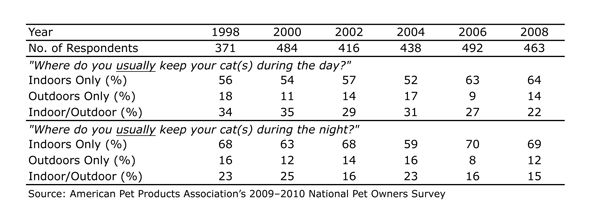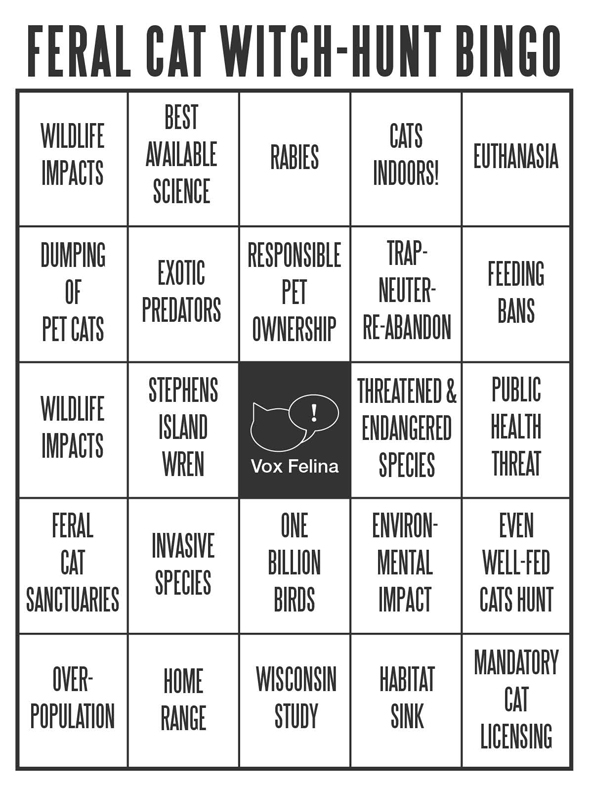Results from the American Pet Products Association’s 2009–2010 National Pet Owners Survey suggest that cats in this country are spending more time indoors than ever before. Although the proportion of owners keeping their cats inside at night has remained relatively steady since 1998 (at approximately 66%), their has been a 14% increase in daytime confinement (from 56% to 64%) over the same period. [1]

It must be noted that owners were asked where they usually kept their cat(s), thereby raising some doubts about the accuracy of their responses. (There are actually two issues here: first is the level of truthfulness—did owners, intentionally or not, provide accurate information? But there is also the obvious ambiguity surrounding the term usually.) Nevertheless, these results correspond reasonably well with those of two earlier surveys: one commissioned by the American Bird Conservancy (ABC) in 1997, [2] the other conducted by Clancy et al. in 2001 [3] (the only other surveys I’ve found that investigated this issue specifically).
The ABC’s study (in which 250 cat owners participated in a telephone survey) indicated that “35% keep their cats indoors all of the time,” while “31% keep them indoors mostly with some outside access.” [2]
The 2001 survey included 168 cat owners, each of whom was part of the Feline Health Study, conducted at the Foster Hospital for Small Animals, Cummings School of Veterinary Medicine, Tufts University. Sixty percent of these cats were “strictly indoor cats,” while 40% “had some level of outdoor access.” [3] Probing further, Clancy et al. discovered that nearly half of the cats with outdoor access were outside for two or fewer hours a day. And 29% of them were outdoors for less than an hour each day. [3]
Considering the differences in sampling (most notably the fact that participants in the 2001 survey were all clients of a veterinary hospital, whereas APPA survey results for 2000 indicate that 27% of cat owners did not visit the vet in the previous 12 months), and the inherent uncertainty surrounding the terms mostly, usually, and some, the results of these three surveys are remarkably similar.
Counting Cats
Such findings are critical for developing accurate estimates of the number of birds killed by cats (assuming a reasonable level of accuracy is achievable, given the complexity of the issue). Simply put, cats that don’t go outside can’t kill birds.
Recognizing this, some researchers have inflated their figures for cats allowed outdoors. [4–6]
Dauphiné and Cooper, [6] for instance, cite the APPA’s 2007–2008 survey when referring to the number of owned cats in the U.S., but either ignored or overlooked its findings about confinement: 63% of owners reported that they kept their cat(s) indoors during the day, 70% during the night. (It’s also possible that the authors consulted only the APPA’s online summary, which probably didn’t include this information.)
By contrast, Dauphiné and Cooper claim that 65% of pet cats “are free-ranging outdoor cats for at least some portion of the day,” [6] citing not the APPA survey, but Linda Winter’s 2004 paper, “Trap-neuter-release programs: the reality and the impacts” (which can be downloaded here). Indeed, Winter, the former director of the ABC’s Cats Indoors! campaign, had suggested as much—misrepresenting the findings of a study commissioned by her own organization:
“A 1997 nationwide random telephone survey indicated that 66% of cat owners let their cats outdoors some or all of the time.” [7]
Double the proportion of cats allowed outdoors, and—just like that—the number of birds killed by pet cats doubles too. (Dauphiné and Cooper actually go much further, employing some grossly inflated predation rates as well.)
Counting Birds
Of course, such estimates do not necessarily relate directly to population impacts. The predation may be largely compensatory, for example; and there are source-sink dynamics to be considered as well.
Nevertheless, researchers persist—more often, it seems, in pursuit of staggering, media-friendly figures than a better understanding of what’s actually going on (e.g., Dauphiné and Cooper’s bumper-sticker-worthy “one billion birds”). As a result, the scientific literature is plagued with some rather spectacular failures where predation numbers are concerned (e.g., The Wisconsin Study, Christopher Lepczyk’s dissertation, Carol Fiore’s thesis, etc.).
* * *
The surprising level of agreement among the three “outdoor access” studies provides researchers a rare opportunity to agree among themselves. Which, in turn, could move us closer to an honest debate of the larger issues—arguing about which action is most appropriate, for instance, rather than about whose numbers are most valid.
Despite how results of these surveys have been—as recently as last year—overlooked, ignored, and misrepresented, I remain cautiously optimistic. As Patronek has suggested, “predation of songbirds tends to be noticed because it takes place during the day.” [8] It’s time predation research received the same kind of visibility. Sunlight, after all, is said to be the best of disinfectants.
Note: There is a an amendment to this post here.
Literature Cited
1. APPA, 2009–2010 APPA National Pet Owners Survey. 2009, American Pet Products Association: Greenwich, CT.
2. ABC, Human Attitudes and Behavior Regarding Cats. 1997, American Bird Conservancy: Washington, DC. http://www.abcbirds.org/abcprograms/policy/cats/materials/attitudes.pdf
3. Clancy, E.A., Moore, A.S., and Bertone, E.R., “Evaluation of cat and owner characteristics and their relationships to outdoor access of owned cats.” Journal of the American Veterinary Medical Association. 2003. 222(11): p. 1541-1545.
4. Coleman, J.S. and Temple, S.A., On the Prowl, in Wisconsin Natural Resources. 1996, Wisconsin Department of Natural Resources: Madison, WI. p. 4–8. http://dnr.wi.gov/wnrmag/html/stories/1996/dec96/cats.htm
5. Lepczyk, C.A., Mertig, A.G., and Liu, J., “Landowners and cat predation across rural-to-urban landscapes.” Biological Conservation. 2003. 115(2): p. 191-201.
6. Dauphiné, N. and Cooper, R.J., Impacts of Free-ranging Domestic Cats (Felis catus) on birds in the United States: A review of recent research with conservation and management recommendations, in Fourth International Partners in Flight Conference: Tundra to Tropics. 2009. p. 205–219.
7. Winter, L., “Trap-neuter-release programs: the reality and the impacts.” Journal of the American Veterinary Medical Association. 2004. 225(9): p. 1369-1376.
8. Patronek, G.J., “Free-roaming and feral cats—their impact on wildlife and human beings.” Journal of the American Veterinary Medical Association. 1998. 212(2): p. 218–226.




